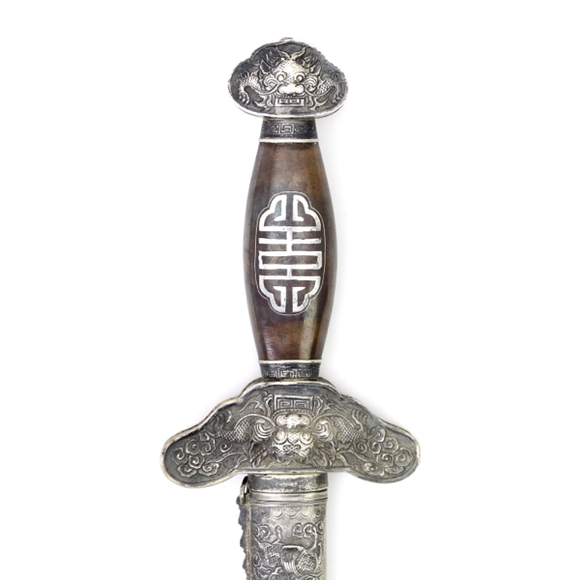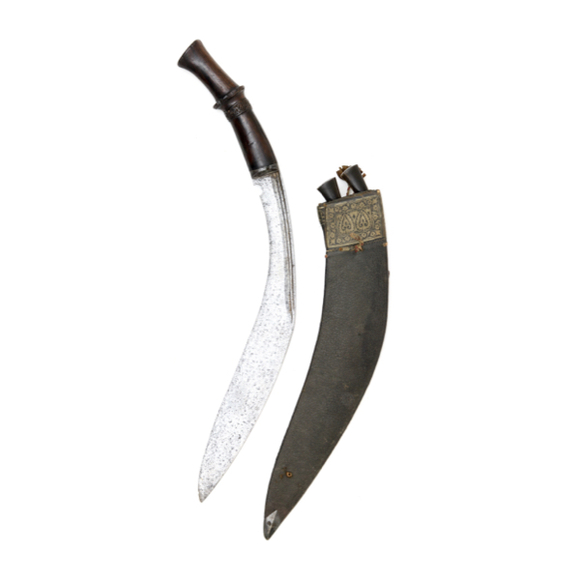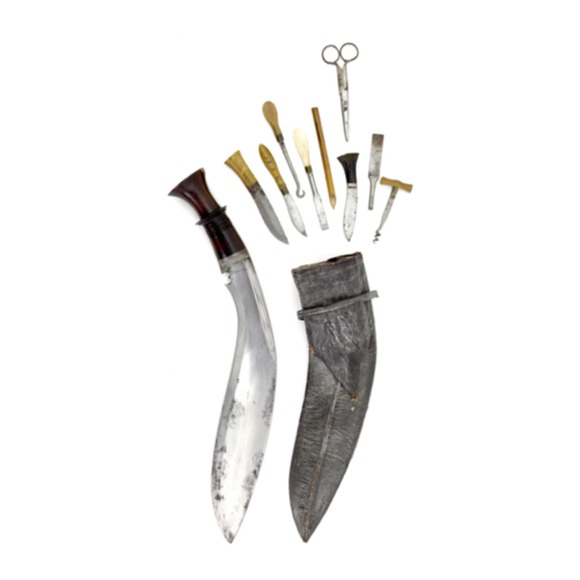A very rare ceremonial variety with copper scabbard inlaid with different alloys, and a brass blade.

74 cm
59.1 cm
Base 5 mm
Middle 3.5 mm
Near tip 2 mm
Base 28 mm
Middle 27 mm
Near tip 23 mm
529 grams
9.8 cm from guard
Vietnam, Nguyễn dynasty
Steel, iron, wood, silver, copper, mother-of-pearl
Late 19th century
A Vietnamese saber or gươm (鎌) from the Nguyễn dynasty.
Blade
It has a somewhat Chinese styled blade of wedged cross-section, with a main groove and a narrow groove that wraps around it. The engravings, on the other hand, are a purely Vietnamese touch. The blade is not very substantial, but thick and stiff enough for use and with a -still sharp- hardened cutting edge. Some minor irregularities in the edge suggest it has been used.
Hilt
The hilt, of typical form for the period, consists of a large flat copper guard with a sharp bend forming a knuckle guard. Guard is framed with silver and inlaid with silver wire in floral motifs. The hardwood downward curving grip is inlaid with mother of pearl on either side, in the shape of a highly stylized archaic dragon.
The back is plated with a pierced silver plate that runs up towards the pommel to form a stylized lion's head, the piercing on the plate being its manes. The ferrule, of silver plate, swells towards the guard in typical Vietnamese fashion. It is engraved with floral designs.
Scabbard
The original scabbard was in fragments so a new scabbard was made by Philip Tom, using the original silver mounts. Each mount is worked in repousse, mouthpiece and chape are decorated with floral elements and dragon, the center mount only decorated with floral mounts. Some damage to the center mount, see photos.
Attribution
Being quite elaborate, the piece was probably made for a higher rank, like an officer. The rank and file's fighting sabers were often quite plain, see for example a signed Vietnamese fighting saber I sold time time ago.

Hoàng Hoa Thám (黄花探), 1858 – 1913, with his saber.
Unknown photographer.
Hoàng Hoa Thám is seen with a somewhat similarly looking saber that is also probably not a ceremonial saber. He was Vietnamese leader of an anti-French rebellion that held out for three decades until he was killed by a French spy.
The saber we have has a different guard, but most likely dates from around the same period.
Conclusion
Overall a nice example of a Vietnamese gươm of the late 19th century. Most that date from this period are purely ornamental, it is nice to see one with a live blade.




















With a very fine Nepalese blade, but kard-like hilt and scabbard.
Early type with very shallow notch in the blade and little flare in the pommel.
20th century military khukurī with many different tools in its back pocket.






